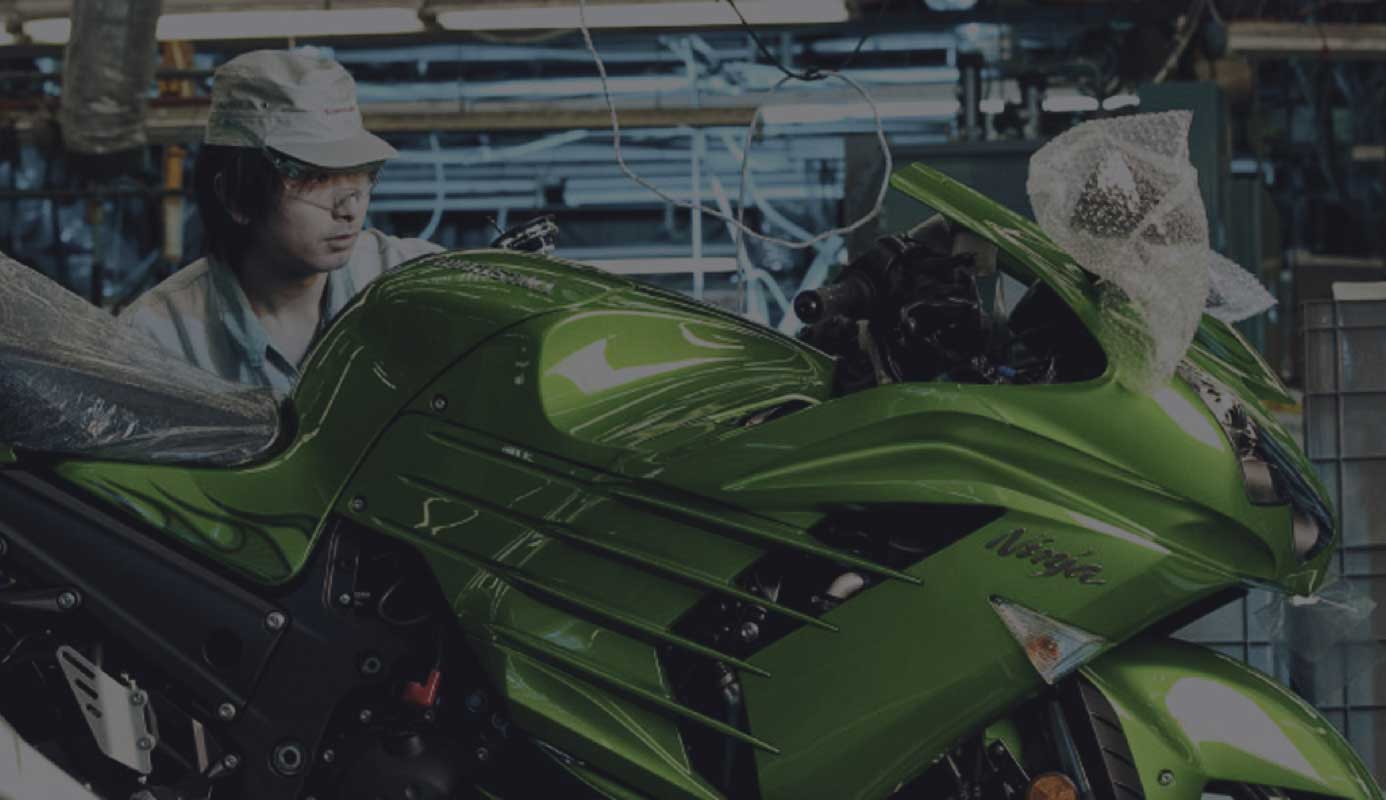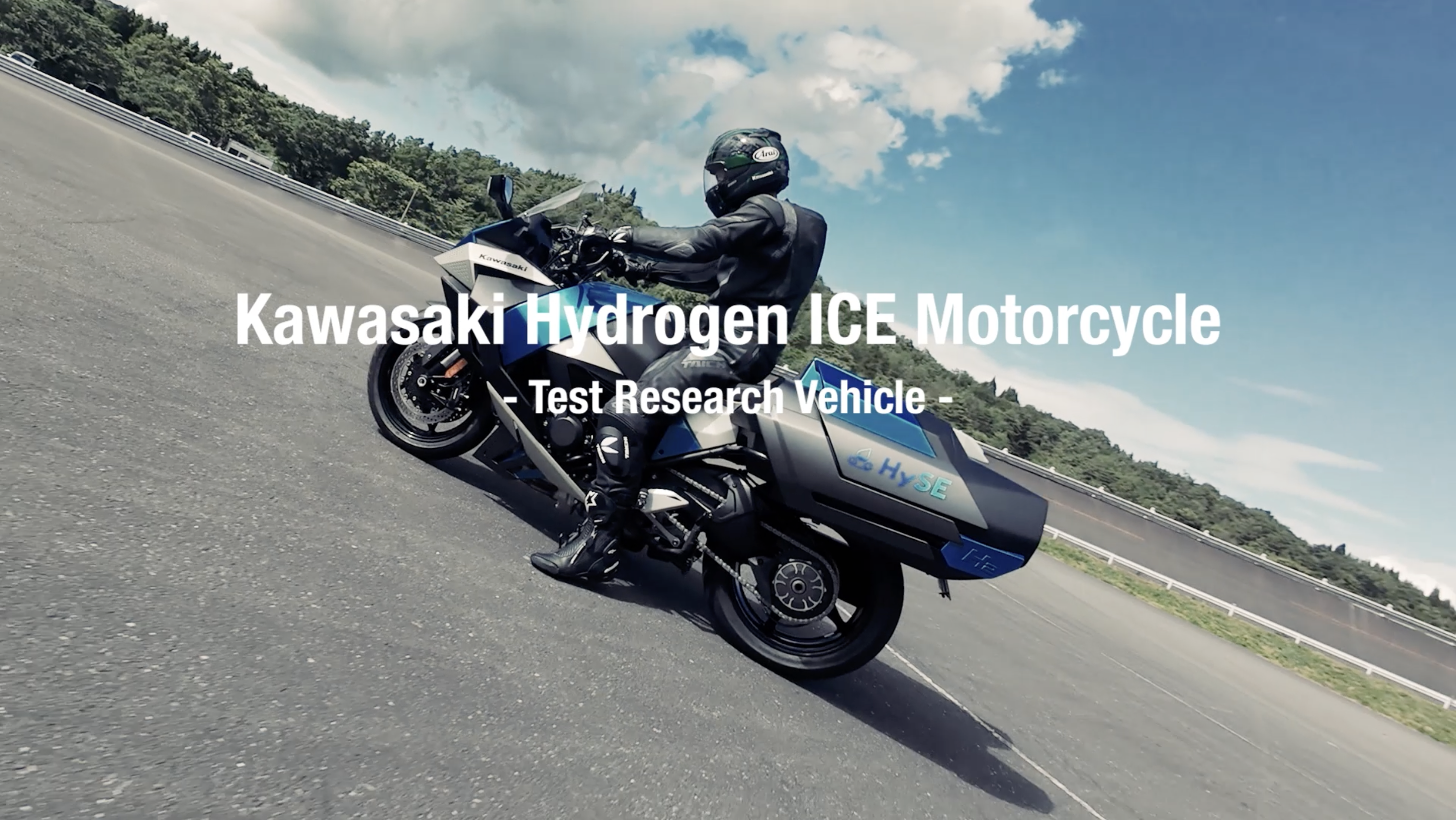main content of page
KAWASAKI HERITAGE |
-
KAWASAKI HEAVY INDUSTRIES, LTD. (KHI)
Few companies in the world can say they build the things that make the world turn. Kawasaki Heavy Industries, Ltd. (KHI), is one of them. Best known commercially for manufacturing powersport products, KHI draws much of its engineering innovations from what it does in the heavy industries. From aircraft engines and bullet trains to bridges and power plants, there’s no limit to what KHI can do.
-
Engineering excellence
When it comes to engineering innovation, KHI is in a league of its own. Kawasaki Motors Ltd. conducted the first* public demonstration of a hydrogen ICE motorcycle from a mass-production motorcycle manufacturer. This motorcycle features a hydrogen engine based on the 998cc in-line four supercharged engine found in the Ninja H2® motorcycle, but with special modifications enabling direct injection of hydrogen fuel into the cylinders. The chassis was also designed to integrate hydrogen fuel canisters and an onboard hydrogen fuel supply system. Hydrogen ICE motorcycles operate on hydrogen combustion, delivering the rumble and pulsating sensation that riders love when twisting the throttle, while emitting mainly water and a very small amount of CO2.
*As of July 20, 2024
-
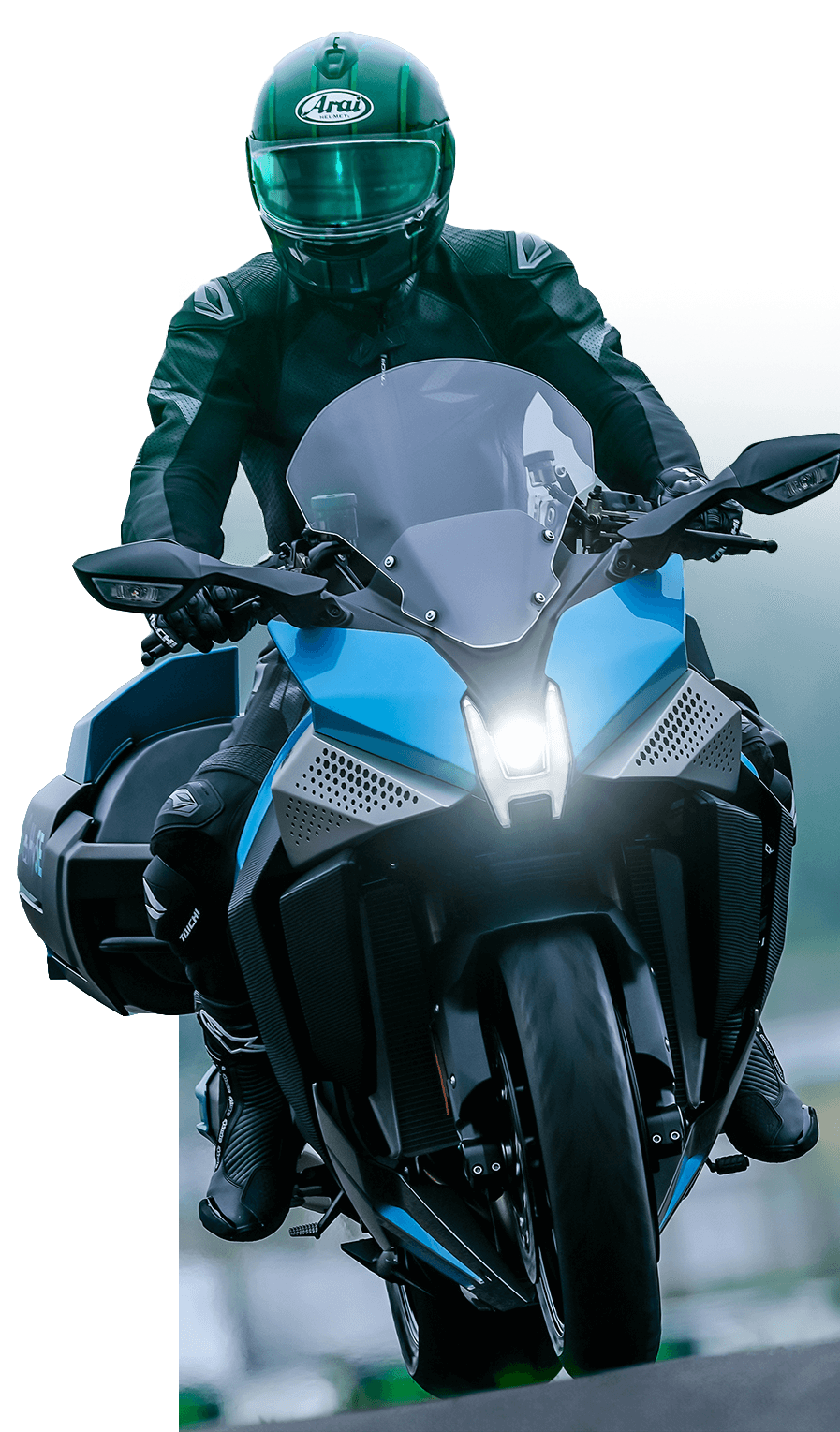
AVIATION
Sportbike or commercial jet, KHI builds the engines that power both. Since 1937, KHI has been a leading manufacturer of aircrafts and aircraft engines, so to say we were born from jets couldn't be more true. From helicopters and commercial jets to 1,441cc sportbikes and 310-hp Jet Ski® watercraft, it's our technology in the sky that ignites our innovation down below.
-

-
AVIATION
Sportbike or commercial jet, KHI builds the engines that power both. Since 1937, KHI has been a leading manufacturer of aircrafts and aircraft engines, so to say we were born from jets couldn't be more true. From helicopters and commercial jets to 1,441cc sportbikes and 310-hp Jet Ski® watercraft, it's our technology in the sky that ignites our innovation down below.
-
BULLET TRAINS
You already know KHI builds machines that move people. But, did you know it also builds machines that move thousands of people - all at once? We're talking trains here. From New York City subway cards to Japan's hyper-speed bullet trains, Kawasaki has been in the business since 1906. Whether a 186-mph bullet train or a 1,441cc Ninja ZX-14R motorcycle, KHI likes to believe that the technology that goes into moving thousands of people has a positive effect on how it goes about moving just one.
-

-

-
BULLET TRAINS
You already know KHI builds machines that move people. But, did you know it also builds machines that move thousands of people - all at once? We're talking trains here. From New York City subway cards to Japan's hyper-speed bullet trains, Kawasaki has been in the business since 1906. Whether a 186-mph bullet train or a 1,441cc Ninja ZX-14R motorcycle, KHI likes to believe that the technology that goes into moving thousands of people has a positive effect on how it goes about moving just one.
PLANTS
Because every Kawasaki motorcycle, ATV, side-by-side and Jet Ski watercraft gets built in a factory, KHI understands we understand the need to be as eco-friendly as possible. Every manufacturing plant, recycling plant or power plant KHI builds is built to be energy efficient and labor saving. The same mindset goes into engineering high performance street water and off-road machines without sacrificing what's good for the environment.
-
ROBOTICS
If robots are the future, then KHI has been shaping it since 1969 when the company built its first industrial robot. KHI continues to be a leader in the development of robots for a diverse number of processes including: assembly, handling, welding, painting and sealing. Kawasaki robot technology is being used every day to manufacture motorcycles and other products.

-

MOTORCYCLE ENGINES
Since KHI built its first motorcycle in 1953, they’ve never stopped pushing technology to arm riders with what they need to dominate the streets. Advanced engineering, exhaustive testing, and tireless passion go into every motorcycle every time rubber hits the road. From industry-first features to the features that have evolved over a long history, KHI’s innovations will never stop feeding the insatiable appetites of riders around the world.

MOTORCYCLE ENGINES
Since KHI built its first motorcycle in 1953, they’ve never stopped pushing technology to arm riders with what they need to dominate the streets. Advanced engineering, exhaustive testing, and tireless passion go into every motorcycle every time rubber hits the road. From industry-first features to the features that have evolved over a long history, KHI’s innovations will never stop feeding the insatiable appetites of riders around the world.
HISTORICAL TIMELINE |
MARCH 1, 1966
American Kawasaki Motorcycle Corp. is established in Delaware with a sales office located at 208 South LaSalle St. Chicago, IL; and a parts warehouse set up in an old meat packing company at 2860 North Lincoln Ave, Chicago, IL.
American Kawasaki Motorcycle Corp., Jim Deehan, a talented road racer and Kawasaki technician, enters and wins first road race in America with the newly released Samurai 250cc A1 at Willow Springs, CA. A1-250cc Samurai twin-cylinder two-stroke.

1967
Kawasaki introduces a new racing machine based on the Samurai 250 called the A1R, featuring racing red fuel tank colors adopted from earlier B8M 125cc racing machines. American Kawasaki executives begin to discuss competition racing in America and the need to stay ahead of other manufacturers when it comes to performance and style.

1969 1 of 2
To increase visibility in racing events a new color is chosen. Kawasaki Racing Green, a special color blended by the famous custom painter Molly (Rollin Sanders) is used.
Kawasaki introduces a new motorcycle, the H1 500cc three-cylinder two-stroke named the Mach III. The motorcycle world is stunned by the Mach III motorcycle’s high performance as it quickly becomes the world’s quickest production motorcycle.

1970
The H1R-500cc Road Racer is based off the street version of the H1 and features a two-stroke, three-cylinder engine.

1971
To expand and strengthen KMC, a new South Region sales and parts operation opens in Atlanta, Georgia.

1972
Kawasaki R&D develops a 450cc works motocross bike named the F12M. Brad Lackey rides the F12M to the championship, winning Kawasaki its first AMA 500cc National Moto-Cross Championship.

1973 1 of 2
KMC test-markets a new product calling it the Kawasaki Jet Ski® watercraft while producing limited sales with their two models, the WSAA and WSAB.
Kawasaki sales commence for the new four-cylinder four-stroke named the Z1-900. The Z1 quickly becomes the performance king of the superbikes by shattering the 24-hour World Record and setting 45 other World and AMA records at Daytona.

1974
Kawasaki Motors Manufacturing Corp. opens its Lincoln, Nebraska facility.

1975 1 of 2
The KZ400 is the first motorcycle assembled in the United States by Kawasaki to roll out of the Lincoln plant on January 22nd.
The Jet Ski® 400 watercraft, also produced in Lincoln, soon follows and Jet Ski becomes a registered trademark of Kawasaki.

1976
Kawasaki celebrates its 10th anniversary in America.
1976 brings two variations of the KZ900 including the KZ900-B1 LTD, which is the first Japanese Custom Cruiser to come from the factory in Lincoln with a lot of chrome and bolt on accessories.

1977
Randy Cleet on the KZ650 sets eight World and AMA endurance records at Daytona, shattering the current 750cc records.

1978
Marcia Holley becomes the first woman to break the 200 MPH barrier on two wheels riding the turbocharged KZ1000. Don Vesco sets the world land speed record of 318.598 MPH aboard the “World’s Fastest Motorcycle” — the Kawasaki turbocharged twin KZ1000 powered streamliner.
1979
Kawasaki Heavy Industries, Ltd. (KHI) develops a single shock suspension system called Uni-Trak®. The revolutionary Uni-Trak system is initially installed on works motocross machines and later became standard on select products. The Uni-Trak becomes the first mass produced linkage system in the motorcycle industry.
1980
The MULE™ utility vehicle—is born in San Diego, California, on a cocktail napkin in August of 1980. This new creation is named the “Pony Truck” and is nicknamed the four-wheeled three-wheeler. Three employees of Rocky Mountain Kawasaki (RMK)—a distributor of KMC—sketch their ideas out with a simple concept in mind: build a vehicle with four wheels that can carry two people and heavier loads than an ATV.

1981 1 of 2
Team Green™ starts in the winter of 1980/1981.
The starting gate drops on the revolutionary Team Green motocross program for the very first time and history is born.
Eddie Lawson wins his first AMA Superbike Championship on the KZ1000 and Formula II 250 AMA Championship on the KR250cc.

1982
8-year-old “Hammerin” Hank Moree races and posts the very first win on the first-ever KX™60 (1983 pre-production) mini-bike at Ponca City. This begins a 19-year legacy of KX60 mini bike domination that continues through 2001 when the KX60 ceases production and is ultimately replaced by the newly updated KX™65.

1983
Wayne Rainey wins the AMA Superbike Championship on GPZ-750.

1984
Kawasaki welcomes the world to a new generation of high-performance motorcycles by introducing the Ninja® 900 to the world press at the famous Laguna Seca Raceway.

1985
The 1985 Vulcan® 750 marks the first time a Kawasaki features a V-twin and is also Kawasaki’s first foray in the cruiser category. The VN750 was originally sold in the US with a 699cc engine before a tariff was lifted in 1986.

1986
THE 20TH ANNIVERSARY OF KMC
Four buildings in Orange County, CA are consolidated into new Irvine corporate headquarters for sales, marketing, planning, finance, legal and administration.

1987
Team Green™ enters the world of off-road racing, winning its first Baja 1000 with established riders Larry Roeseler and Ted Hunnicut.

1988
Kawasaki introduces its first production utility vehicle–the 1988 KAF450-B1. Featuring a pick-up-truck-type design, the Kawasaki MULE™ side x side revolutionized the lightweight utility vehicle category. Powered by a liquid-cooled 454cc twin-cylinder engine mounted in an open-cab utility chassis with independent front and rear suspension, and rolling on four all-terrain tires with rear differential lock feature, the MULE 1000 utility vehicle is an immediate success.

1989
Jeff Ward wins the AMA 500cc National Moto-Cross Championship and becomes the only rider in AMA history to win every class on the same brand of bike, Kawasaki.

1990
One-millionth unit is assembled at the Lincoln assembly plant.
Kawasaki Robotics (USA), Inc. becomes a subsidiary of KMC.

1991
Kawasaki celebrates its 25th anniversary in America.
Scott Russell takes first in the 750 Supersport and Mike Kiedrowski wins the 125cc AMA National Motocross Championship.

1992
Scott Russell wins Daytona 200—the first ever for Kawasaki Motors Corp., U.S.A.
Scott Russell also takes first at the AMA Superbike championship and the AMA 750 Supersport Championship.

1993
Jeff Ward retires with 7 National Championships, 20 Supercross victories and 55 National Motocross wins all on Kawasaki motorcycles.
Pro Circuit racing joins Kawasaki as a factory supported Moto-Cross race team.

1995
Victor Sheldon wins IJSBA Pro Runabout 785 National Championship.
KMC starts first factory sponsored professional Personal Watercraft race team.
Minoru Kanamori crowned IJSBA Pro Runabout 785 World champion and Pro Slalom World champion.
Nicolas Rius wins IJSBA Pro Ski National Championship.

1996 1 of 2
KMC celebrates their 30-year anniversary.
Doug Chandler wins AMA Superbike Championship.
Ricky Carmichael graduates to the pro ranks, leaving behind his legacy as the winningest amateur rider of all time.
Jeff Emig crowned AMA 250cc National MX Champion.

1997
Jeff Emig wins the AMA Supercross Championship and the AMA National Moto-Cross Championship on the factory KX™250 Sr.

1998
The “G” model of the ZX600 (ZX™-6R) is introduced in 1998 cementing Kawasaki as the sportbike to have, with more power resulting from a redesigned airbox, the ZX-6R is able to keep up with the 750cc superbikes of this time.

1999
KMC establishes its Gas Turbine (KGTA) division in Grand Rapids, MI.

2000
Kawasaki introduces the MULE™ 2510 Diesel (KAF950-A1)—the first diesel product in its side x side lineup. The diesel engine allows for better fuel economy and increased cargo capacity and is a popular choice in agriculture where diesel is widely used.

2001 1 of 2
Eric Bostrom wins AMA 600 Supersport Championship.
James Stewart holds the record for most career amateur national championships. He claimed his 11th AMA Amateur National Championship, surpassing Ricky Carmichael as the all-time winningest amateur rider.
Ricky Carmichael wins the AMA Supercross and National Moto-Cross Championships on the KX™250 SR.

2002
Team Green™ racing team rider Jeff Fredette is inducted into the AMA Motorcycle Hall of Fame.
James Stewart takes AMA 125cc National MX Championship.

2003
Streetbike Shootout National Champion, Rickey Gadson, finishes the season with 6 wins out of 8 races.

2004
Tommy Hayden takes first in the AMA 600 Supersport Championship followed by his brother, Roger Hayden in second, both aboard Ninja ZX600 motorcycles.

2005
Kawasaki, continuing its legacy as a pioneer in the utility vehicle market, release the world’s first convertible MULE™ side x side. At first glance the MULE 3010 Trans4x4® looks like other 3000 Series MULE side x sides, but the Trans4x4 model features two rows of seats, enabling it to accommodate up to four passengers and giving the Trans4x4 greater flexibility. In four-passenger mode, a family, work crew or group of hunters can be accommodated; in two-passenger mode, cargo space is maximized.

2006 1 of 2
KMC celebrates their 40th anniversary.
James Stewart wins the World FIM Supercross Championship.

2007
Ryan Villopoto captures the Supercross Lites West and the AMA MX Lites title.

2008
Kawasaki appeals to the outdoor segment with its 2008 Teryx™ 750 4x4 by offering three models in RealTree® camo which is designed to keep the vehicle from being spotted easily. The versatile side by side gives hunters a new way to bring two people and all of their gear out on the hunt.

2009
Blake Baggett adds 250A/Pro Sport title to his list of championships.
Team Green™ dominates Loretta Lynn’s Amateur Motocross with 17 championships.
Teryx® claims BAJA 500 and BAJA 1000 victories.

2010
Kawasaki takes the Supernaked concept in a new direction introducing the all-new Z1000 designed with complete design freedom. The new engine pumps out more horsepower and is hung in a new all-aluminum twin-spar backbone frame. It's finished off with new bodywork and a riding position that emphasizes both ride comfort and control. About the only thing that didn't change is the Z1000 mission: To provide an exhilarating ride!

2011
The Jet Ski® Ultra® 300X watercraft is introduced—raising the bar, this is the first time anyone went over 300 HP and the first time a manufacturer produced a supercharged engine available in a production watercraft.
New technology features like the electronic throttle valves, new riding modes like Fuel Economy Assistance Mode, One-touch 5 mph Mode and Electronic Cruise Control, and an electric trim-control system all contribute to its dominant performance.

2012
Blake Baggett wins the AMA National Moto-Cross Championship on KX™250F.

2014
Created to be the most radical Supernaked in its highly competitive category, the new Z1000 takes a significant step forward in both looks and feel by introducing the sugomi design. Visually, the new model’s sugomi design advances the mass-forward crouching concept of its predecessor. Sugomi: The Japanese word sugomi describes the intense aura or energy given off by a person or object of greatness and felt by the viewer. Someone, or something, possessing sugomi inspires awe, leaves an indelible impression, is imposing in stature or ability, and commands respect. In the new Z1000, sugomi is evident both in its fiercely intense design and the exhilarating performance it delivers, radiating as a palpable energy.

2015 1 of 2
The Kawasaki Ninja H2R hypersport motorcycle is an engineering marvel, made possible only through the sourcing of technological expertise from multiple divisions of Kawasaki Heavy Industries, Ltd. (KHI). The result of this unprecedented collaboration is a system of carefully crafted premium components that work in concert to create an unbelievably powerful machine—one that’s more than worthy of the legendary H2 name.
In 2015, Kawasaki changes the utility side x side market with the introduction of the MULE PRO-FXT™. Since the inception of the MULE over 35 years ago, and with over 130 years of Kawasaki Heavy Industries, Ltd. engineering, the latest edition of the MULE PRO-FXT has become a truly innovative new way to work and play. This full-size, high capacity, three-to-six passenger Trans Cab™ model brings a whole new level of comfort and performance.

2016
Exactly 50 years ago, on March 1, 1966, American Kawasaki Motorcycle Corp. (AKMC) opened for business in Chicago, with a modest sales office at 208 South La Salle Street and a two-story parts warehouse at 2860 North Lincoln Avenue.
Today KMC has nearly 1,100 dealers in all 50 states and offers a wide range of products in five categories, including streetbikes, off-road motorcycles, ATVs, MULE™ utility vehicles, and JET SKI® personal watercraft. Many of the 4-wheel product and personal watercraft are assembled at Kawasaki Motors Manufacturing Corp., U.S.A. in Lincoln, Nebraska.

2023 1 of 5
Jet Ski® 50th Anniversary
The name needs little introduction when it represents an entire category of personal
watercraft. In 2023, Kawasaki Jet Ski® watercraft celebrated 50 years of Good Times on the water and 50 years of making waves with industry-leading performance and technology.
KX™ 50th Anniversary
The Kawasaki KX™ celebrates 50 years as one of the most dominant brands of motorcycles in motocross: 50 years of Kawasaki KX™ athletes gracing the top step of countless motocross and supercross races, and 50 years of relentless commitment to engineering next-level, championship-proven race machines.
Ninja® 40th Anniversary
Kawasaki celebrates the 40th anniversary of the most iconic name in Kawasaki sportbike history. From the first-ever model given the Ninja® name in 1984, the Kawasaki Ninja® GPz900R, to the current-day lineup, Ninja has become more than just a recognizable name over the last 40 years, it's become a way of life.
Introduction of MULE PRO 1000 series
Kawasaki introduces a new series of side x sides to its 2024 MULE™ lineup with the MULE PRO-FX™ 1000, MULE PRO-FXR™ 1000, and MULE PRO-FXT™ 1000 models. Kawasaki's MULE PRO 1000 models are renowned as full-size utility/recreation side x sides that offer high capability, durability, and class-leading comfort.
Introduction of EV/Hybrid products
Kawasaki introduces an electric and hybrid lineup that kicked off their "Go with Green Power" initiative to achieve carbon neutrality and keep the Good Times rolling for generations to come. With innovation in Kawasaki's DNA, the lineup will continue to expand for years to come.
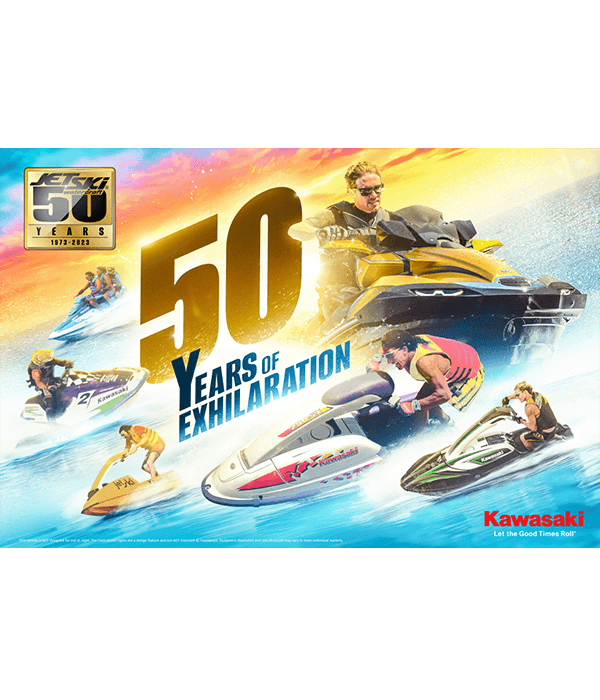
2024 1 of 4
Introduction of first inline-4 in a SxS (RIDGE)
For the first time ever, a Kawasaki side x side features an all-new 999cc in-line 4-cylinder engine. The game-changing Kawasaki-built in-line 4-cylinder engine delivers an impressive 92 horsepower* in the RIDGE®, while RIDGE® XR goes above and beyond with 116 horsepower*.
*This vehicle's HP was measured according to ISO standard 4106. This ISO standard measures HP differently than the SAE standards by which the horsepower of many cars is measured. As a result, the referenced HP measurement may be higher than if it were measured by an SAE standard.
Introduction of first fishing-focused Jet Ski
In 2024, the Jet Ski® Ultra® 160LX-S Angler splashed onto the scene as a fishing-focused personal watercraft designed to be a compact powerhouse that effortlessly takes the rider to their favorite fishing spots. Its smaller size grants access to shallow, secluded areas that larger vessels can't reach so fishing enthusiasts can catch the Good Times.
Engineering Excellence (1 of 2)
When it comes to engineering innovation, KHI is in a league of its own. Kawasaki Motors Ltd. conducted the first* public demonstration of a hydrogen ICE motorcycle from a mass-production motorcycle manufacturer. This motorcycle features a hydrogen engine based on the 998cc in-line four supercharged engine found in the Ninja H2® motorcycle, but with special modifications enabling direct injection of hydrogen fuel into the cylinders.
Engineering Excellence (2 of 2)
The chassis was also designed to integrate hydrogen fuel canisters and an onboard hydrogen fuel supply system. Hydrogen ICE motorcycles operate on hydrogen combustion, delivering the rumble and pulsating sensation that riders love when twisting the throttle, while emitting mainly water and a very small amount of CO2.
*As of July 20, 2024
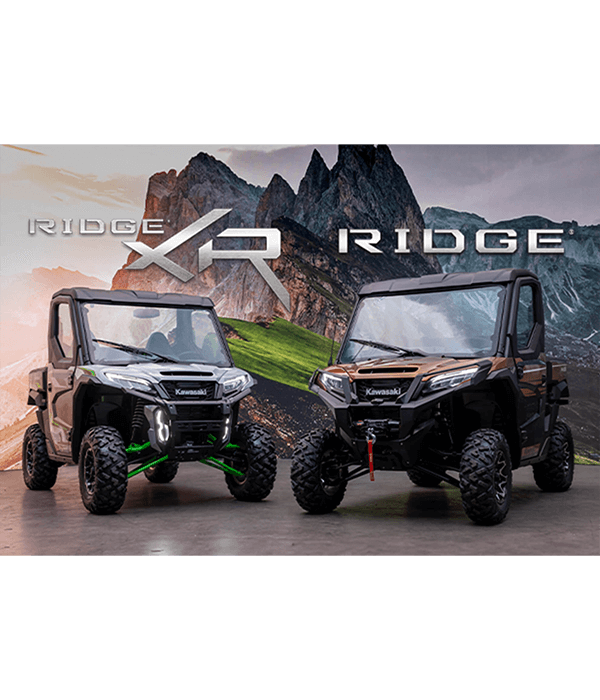
|
HISTORICAL TIMELINE
|

1966
American Kawasaki Motorcycle Corp. is established in Delaware with a sales office located at 208 South LaSalle St. Chicago, IL; and a parts warehouse set up in an old meat packing company at 2860 North Lincoln Ave, Chicago, IL.
American Kawasaki Motorcycle Corp., Jim Deehan, a talented road racer and Kawasaki technician, enters and wins first road race in America with the newly released Samurai 250cc A1 at Willow Springs, CA. A1-250cc Samurai twin-cylinder two-stroke.

1967
Kawasaki introduces a new racing machine based on the Samurai 250 called the A1R, featuring racing red fuel tank colors adopted from earlier B8M 125cc racing machines. American Kawasaki executives begin to discuss competition racing in America and the need to stay ahead of other manufacturers when it comes to performance and style.

1969
To increase visibility in racing events a new color is chosen. Kawasaki Racing Green, a special color blended by the famous custom painter Molly (Rollin Sanders) is used.

1969
Kawasaki introduces a new motorcycle, the H1 500cc three-cylinder two-stroke named the Mach III. The motorcycle world is stunned by the Mach III motorcycle’s high performance as it quickly becomes the world’s quickest production motorcycle.

1970
The H1R-500cc Road Racer is based off the street version of the H1 and features a two-stroke, three-cylinder engine.

1971
To expand and strengthen KMC, a new South Region sales and parts operation opens in Atlanta, Georgia.

1972
Kawasaki R&D develops a 450cc works motocross bike named the F12M. Brad Lackey rides the F12M to the championship, winning Kawasaki its first AMA 500cc National Moto-Cross Championship.

1973
KMC test-markets a new product calling it the Kawasaki Jet Ski® watercraft while producing limited sales with their two models, the WSAA and WSAB.

1973
Kawasaki sales commence for the new four-cylinder four-stroke named the Z1-900. The Z1 quickly becomes the performance king of the superbikes by shattering the 24-hour World Record and setting 45 other World and AMA records at Daytona.

1974
Kawasaki Motors Manufacturing Corp. opens its Lincoln, Nebraska facility.

1975
The KZ400 is the first motorcycle assembled in the United States by Kawasaki to roll out of the Lincoln plant on January 22nd.

1975
The Jet Ski® 400 watercraft, also produced in Lincoln, soon follows and Jet Ski becomes a registered trademark of Kawasaki.

1976
Kawasaki celebrates its 10th anniversary in America.
1976 brings two variations of the KZ900 including the KZ900-B1 LTD, which is the first Japanese Custom Cruiser to come from the factory in Lincoln with a lot of chrome and bolt on accessories.

1977
Randy Cleet on the KZ650 sets eight World and AMA endurance records at Daytona, shattering the current 750cc records.

1978
Marcia Holley becomes the first woman to break the 200 MPH barrier on two wheels riding the turbocharged KZ1000. Don Vesco sets the world land speed record of 318.598 MPH aboard the “World’s Fastest Motorcycle” — the Kawasaki turbocharged twin KZ1000 powered streamliner.

1979
Kawasaki Heavy Industries, Ltd. (KHI) develops a single shock suspension system called Uni-Trak®. The revolutionary Uni-Trak system is initially installed on works motocross machines and later became standard on select products. The Uni-Trak becomes the first mass produced linkage system in the motorcycle industry.

1980
The MULE™ utility vehicle—is born in San Diego, California, on a cocktail napkin in August of 1980. This new creation is named the “Pony Truck” and is nicknamed the four-wheeled three-wheeler. Three employees of Rocky Mountain Kawasaki (RMK)—a distributor of KMC—sketch their ideas out with a simple concept in mind: build a vehicle with four wheels that can carry two people and heavier loads than an ATV.

1981
Team Green™ starts in the winter of 1980/1981.
The starting gate drops on the revolutionary Team Green motocross program for the very first time and history is born.

1981
Eddie Lawson wins his first AMA Superbike Championship on the KZ1000 and Formula II 250 AMA Championship on the KR250cc.

1982

1982
8-year-old “Hammerin” Hank Moree races and posts the very first win on the first-ever KX™60 (1983 pre-production) mini-bike at Ponca City. This begins a 19-year legacy of KX60 mini bike domination that continues through 2001 when the KX60 ceases production and is ultimately replaced by the newly updated KX™65.

1983
Wayne Rainey wins the AMA Superbike Championship on GPZ-750.

1984
Kawasaki welcomes the world to a new generation of high-performance motorcycles by introducing the Ninja® 900 to the world press at the famous Laguna Seca Raceway.

1985
The 1985 Vulcan® 750 marks the first time a Kawasaki features a V-twin and is also Kawasaki’s first foray in the cruiser category. The VN750 was originally sold in the US with a 699cc engine before a tariff was lifted in 1986.

1986
THE 20TH ANNIVERSARY OF KMC
Four buildings in Orange County, CA are consolidated into new Irvine corporate headquarters for sales, marketing, planning, finance, legal and administration.

1987
Team Green™ enters the world of off-road racing, winning its first Baja 1000 with established riders Larry Roeseler and Ted Hunnicut.

1988
Kawasaki introduces its first production utility vehicle–the 1988 KAF450-B1. Featuring a pick-up-truck-type design, the Kawasaki MULE™ side x side revolutionized the lightweight utility vehicle category. Powered by a liquid-cooled 454cc twin-cylinder engine mounted in an open-cab utility chassis with independent front and rear suspension, and rolling on four all-terrain tires with rear differential lock feature, the MULE 1000 utility vehicle is an immediate success.

1989
Jeff Ward wins the AMA 500cc National Moto-Cross Championship and becomes the only rider in AMA history to win every class on the same brand of bike, Kawasaki.

1990
One-millionth unit is assembled at the Lincoln assembly plant.
Kawasaki Robotics (USA), Inc. becomes a subsidiary of KMC.

1991
Kawasaki celebrates its 25th anniversary in America.
Scott Russell takes first in the 750 Supersport and Mike Kiedrowski wins the 125cc AMA National Motocross Championship.

1992
Scott Russell wins Daytona 200—the first ever for Kawasaki Motors Corp., U.S.A.
Scott Russell also takes first at the AMA Superbike championship and the AMA 750 Supersport Championship.

1993
Jeff Ward retires with 7 National Championships, 20 Supercross victories and 55 National Motocross wins all on Kawasaki motorcycles.
Pro Circuit racing joins Kawasaki as a factory supported Moto-Cross race team.

1995
Victor Sheldon wins IJSBA Pro Runabout 785 National Championship.
KMC starts first factory sponsored professional Personal Watercraft race team.
Minoru Kanamori crowned IJSBA Pro Runabout 785 World champion and Pro Slalom World champion.
Nicolas Rius wins IJSBA Pro Ski National Championship.

1996
KMC celebrates their 30-year anniversary.
Doug Chandler wins AMA Superbike Championship.

1996
Ricky Carmichael graduates to the pro ranks, leaving behind his legacy as the winningest amateur rider of all time.
Jeff Emig crowned AMA 250cc National MX Champion.

1997
Jeff Emig wins the AMA Supercross Championship and the AMA National Moto-Cross Championship on the factory KX™250 Sr.

1998
The “G” model of the ZX600 (ZX™-6R) is introduced in 1998 cementing Kawasaki as the sportbike to have, with more power resulting from a redesigned airbox, the ZX-6R is able to keep up with the 750cc superbikes of this time.

1999
KMC establishes its Gas Turbine (KGTA) division in Grand Rapids, MI.

2000
Kawasaki introduces the MULE™ 2510 Diesel (KAF950-A1)—the first diesel product in its side x side lineup. The diesel engine allows for better fuel economy and increased cargo capacity and is a popular choice in agriculture where diesel is widely used.

2001
Eric Bostrom wins AMA 600 Supersport Championship.
James Stewart holds the record for most career amateur national championships. He claimed his 11th AMA Amateur National Championship, surpassing Ricky Carmichael as the all-time winningest amateur rider.

2001
Ricky Carmichael wins the AMA Supercross and National Moto-Cross Championships on the KX™250 SR.

2002
Team Green™ racing team rider Jeff Fredette is inducted into the AMA Motorcycle Hall of Fame.
James Stewart takes AMA 125cc National MX Championship.

2003
Streetbike Shootout National Champion, Rickey Gadson, finishes the season with 6 wins out of 8 races.

2004
Tommy Hayden takes first in the AMA 600 Supersport Championship followed by his brother, Roger Hayden in second, both aboard Ninja ZX600 motorcycles.

2005
Kawasaki, continuing its legacy as a pioneer in the utility vehicle market, release the world’s first convertible MULE™ side x side. At first glance the MULE 3010 Trans4x4® looks like other 3000 Series MULE side x sides, but the Trans4x4 model features two rows of seats, enabling it to accommodate up to four passengers and giving the Trans4x4 greater flexibility. In four-passenger mode, a family, work crew or group of hunters can be accommodated; in two-passenger mode, cargo space is maximized.

2006
KMC celebrates their 40th anniversary.

2006
James Stewart wins the World FIM Supercross Championship.

2007
Ryan Villopoto captures the Supercross Lites West and the AMA MX Lites title.

2008
Kawasaki appeals to the outdoor segment with its 2008 Teryx™ 750 4x4 by offering three models in RealTree® camo which is designed to keep the vehicle from being spotted easily. The versatile side by side gives hunters a new way to bring two people and all of their gear out on the hunt.

2009
Blake Baggett adds 250A/Pro Sport title to his list of championships.
Team Green™ dominates Loretta Lynn’s Amateur Motocross with 17 championships.
Teryx® claims BAJA 500 and BAJA 1000 victories.

2010
Kawasaki takes the Supernaked concept in a new direction introducing the all-new Z1000 designed with complete design freedom. The new engine pumps out more horsepower and is hung in a new all-aluminum twin-spar backbone frame. It's finished off with new bodywork and a riding position that emphasizes both ride comfort and control. About the only thing that didn't change is the Z1000 mission: To provide an exhilarating ride!

2011
The Jet Ski® Ultra® 300X watercraft is introduced—raising the bar, this is the first time anyone went over 300 HP and the first time a manufacturer produced a supercharged engine available in a production watercraft.
New technology features like the electronic throttle valves, new riding modes like Fuel Economy Assistance Mode, One-touch 5 mph Mode and Electronic Cruise Control, and an electric trim-control system all contribute to its dominant performance.

2012
Blake Baggett wins the AMA National Moto-Cross Championship on KX™250F.

2014
Created to be the most radical Supernaked in its highly competitive category, the new Z1000 takes a significant step forward in both looks and feel by introducing the sugomi design. Visually, the new model’s sugomi design advances the mass-forward crouching concept of its predecessor. Sugomi: The Japanese word sugomi describes the intense aura or energy given off by a person or object of greatness and felt by the viewer. Someone, or something, possessing sugomi inspires awe, leaves an indelible impression, is imposing in stature or ability, and commands respect. In the new Z1000, sugomi is evident both in its fiercely intense design and the exhilarating performance it delivers, radiating as a palpable energy.

2015
The Kawasaki Ninja H2R hypersport motorcycle is an engineering marvel, made possible only through the sourcing of technological expertise from multiple divisions of Kawasaki Heavy Industries, Ltd. (KHI). The result of this unprecedented collaboration is a system of carefully crafted premium components that work in concert to create an unbelievably powerful machine—one that’s more than worthy of the legendary H2 name.

2015
In 2015, Kawasaki changes the utility side x side market with the introduction of the MULE PRO-FXT™. Since the inception of the MULE over 35 years ago, and with over 130 years of Kawasaki Heavy Industries, Ltd. engineering, the latest edition of the MULE PRO-FXT has become a truly innovative new way to work and play. This full-size, high capacity, three-to-six passenger Trans Cab™ model brings a whole new level of comfort and performance.

2016
Exactly 50 years ago, on March 1, 1966, American Kawasaki Motorcycle Corp. (AKMC) opened for business in Chicago, with a modest sales office at 208 South La Salle Street and a two-story parts warehouse at 2860 North Lincoln Avenue.
Today KMC has nearly 1,100 dealers in all 50 states and offers a wide range of products in five categories, including streetbikes, off-road motorcycles, ATVs, MULE™ utility vehicles, and JET SKI® personal watercraft. Many of the 4-wheel product and personal watercraft are assembled at Kawasaki Motors Manufacturing Corp., U.S.A. in Lincoln, Nebraska.

2023
Jet Ski® 50th Anniversary
The name needs little introduction when it represents an entire category of personal
watercraft. In 2023, Kawasaki Jet Ski® watercraft celebrated 50 years of Good Times on the water and 50 years of making waves with industry-leading performance and technology.
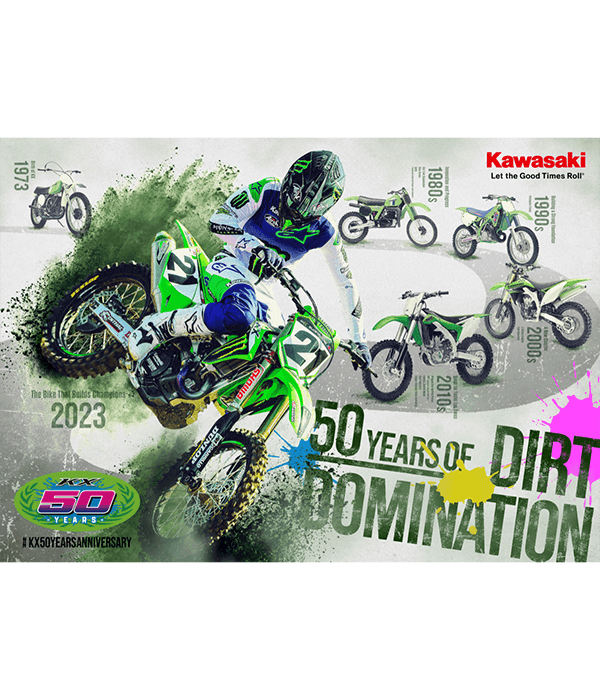
2023
KX™ 50th Anniversary
The Kawasaki KX™ celebrates 50 years as one of the most dominant brands of motorcycles in motocross: 50 years of Kawasaki KX™ athletes gracing the top step of countless motocross and supercross races, and 50 years of relentless commitment to engineering next-level, championship-proven race machines.
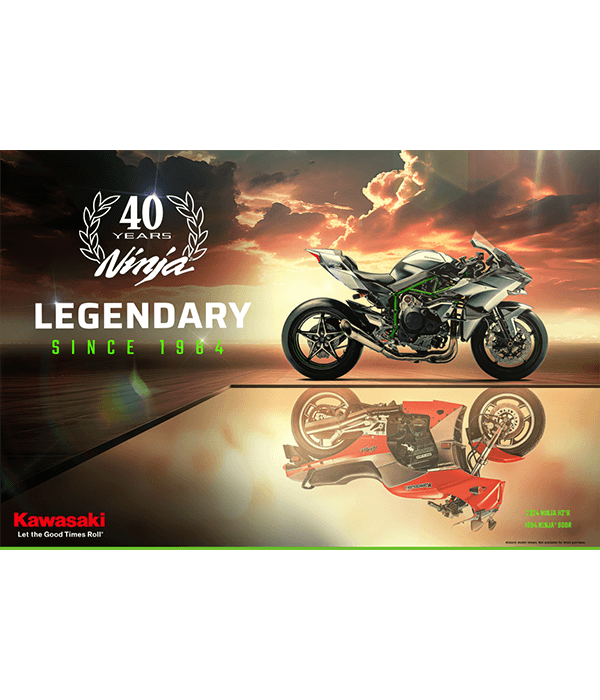
2023
Ninja® 40th Anniversary
Kawasaki celebrates the 40th anniversary of the most iconic name in Kawasaki sportbike history. From the first-ever model given the Ninja® name in 1984, the Kawasaki Ninja® GPz900R, to the current-day lineup, Ninja has become more than just a recognizable name over the last 40 years, it's become a way of life.
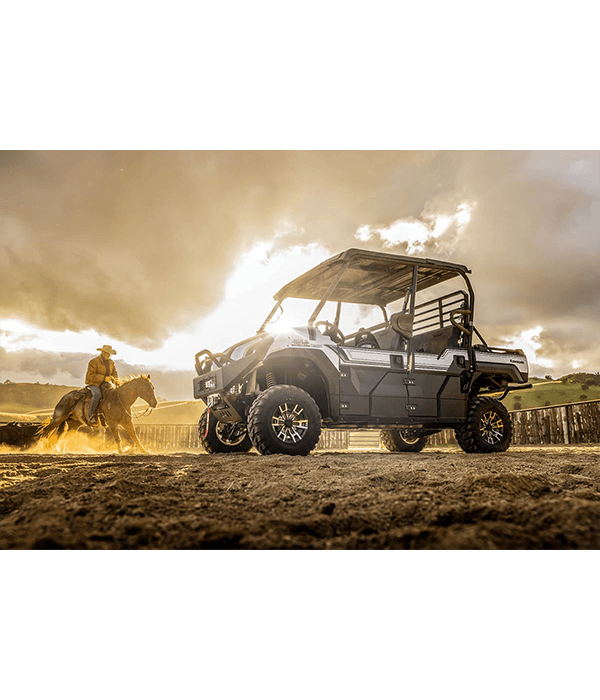
2023
Introduction of MULE PRO 1000 series
Kawasaki introduces a new series of side x sides to its 2024 MULE™ lineup with the MULE PRO-FX™ 1000, MULE PRO-FXR™ 1000, and MULE PRO-FXT™ 1000 models. Kawasaki's MULE PRO 1000 models are renowned as full-size utility/recreation side x sides that offer high capability, durability, and class-leading comfort.
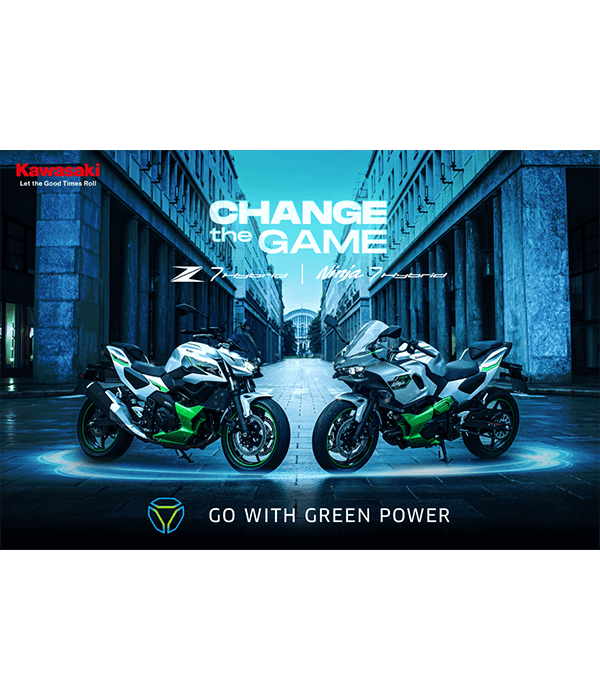
2023
Introduction of EV/Hybrid products
Kawasaki introduces an electric and hybrid lineup that kicked off their "Go with Green Power" initiative to achieve carbon neutrality and keep the Good Times rolling for generations to come. With innovation in Kawasaki's DNA, the lineup will continue to expand for years to come.

2024
Introduction of first inline-4 in a SxS (RIDGE)
For the first time ever, a Kawasaki side x side features an all-new 999cc in-line 4-cylinder engine. The game-changing Kawasaki-built in-line 4-cylinder engine delivers an impressive 92 horsepower* in the RIDGE®, while RIDGE® XR goes above and beyond with 116 horsepower*.
*This vehicle's HP was measured according to ISO standard 4106. This ISO standard measures HP differently than the SAE standards by which the horsepower of many cars is measured. As a result, the referenced HP measurement may be higher than if it were measured by an SAE standard.
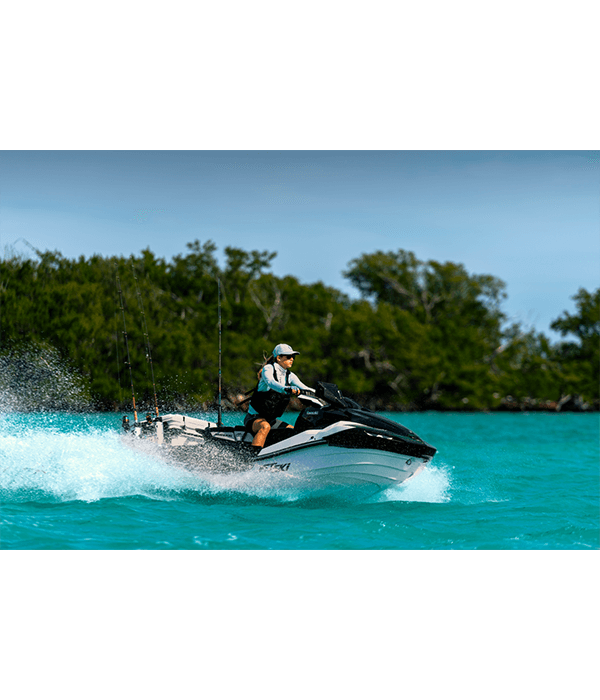
2024
Introduction of first fishing-focused Jet Ski
In 2024, the Jet Ski® Ultra® 160LX-S Angler splashed onto the scene as a fishing-focused personal watercraft designed to be a compact powerhouse that effortlessly takes the rider to their favorite fishing spots. Its smaller size grants access to shallow, secluded areas that larger vessels can't reach so fishing enthusiasts can catch the Good Times.
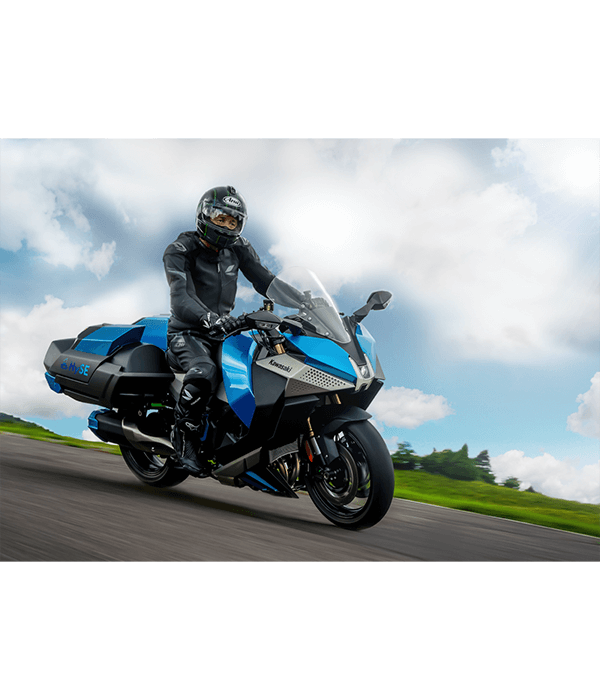
2024
Engineering Excellence (1 of 2)
When it comes to engineering innovation, KHI is in a league of its own. Kawasaki Motors Ltd. conducted the first* public demonstration of a hydrogen ICE motorcycle from a mass-production motorcycle manufacturer. This motorcycle features a hydrogen engine based on the 998cc in-line four supercharged engine found in the Ninja H2® motorcycle, but with special modifications enabling direct injection of hydrogen fuel into the cylinders.
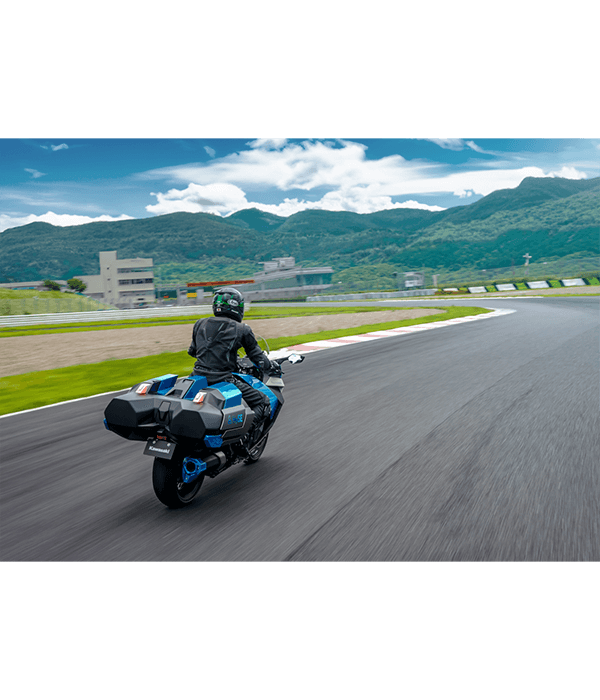
2024
Engineering Excellence (2 of 2)
The chassis was also designed to integrate hydrogen fuel canisters and an onboard hydrogen fuel supply system. Hydrogen ICE motorcycles operate on hydrogen combustion, delivering the rumble and pulsating sensation that riders love when twisting the throttle, while emitting mainly water and a very small amount of CO2.
*As of July 20, 2024
